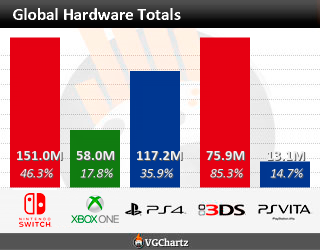
Why am I so convinced that the Nvidia Shield will be dead on arrival, and fail to dent the handheld market dominated by Sony Corporation (ADR) (NYSE:SNE) and Nintendo? Let’s take a look at the key facts.
Tech specs
Before I tear into the NVIDIA Corporation (NASDAQ:NVDA) Shield’s numerous flaws, let’s take a look at this product’s technical specifications. The console, which is powered by Nvidia’s Tegra 4 chip and has a 5-inch, high-definition multi-touch display, sports a full-size “console-grade” controller that closely resembles a Microsoft Corporation (NASDAQ:MSFT) XBOX 360 controller. It is also equipped with stereo speakers, WiFi, Bluetooth, a GPS, a microSD storage slot, a headphone jack and an HDMI output. The console runs on Google Inc (NASDAQ:GOOG) Android 4.2 (Jelly Bean) and is currently priced at $349.
The Shield is considerably bulkier than its primary handheld competitors – Sony Corporation (ADR) (NYSE:SNE)’s PS Vita and Nintendo’s 3DS. It is also much more expensive than both products – the PS Vita retails for $250 while the 3DS costs $170.
Pricing
That brings us to the first problem with the Shield. According to the next chart from VGChartz, the cheaper 3DS, which boasts a simulated 3D effect that does not require 3D glasses, is currently the best-selling handheld console worldwide, claiming 86% of the market, while the pricier PS Vita only has a 14% share. North American numbers are roughly the same.
By comparison, the aging full-size Microsoft Corporation (NASDAQ:MSFT) XBOX 360 and Sony Corporation (ADR) (NYSE:SNE) Playstation 3 consoles now sell for $300 and $250, respectively, with bundled games and extra peripherals. Even the basic version of Nintendo’s eighth-generation Wii U sells for $300.
This means that NVIDIA Corporation (NASDAQ:NVDA) is about to release the most expensive console in the market, in the handheld sector where price and portability – two areas where the Nvidia Shield is lacking – have proven to be more important than raw horsepower.
In other words, NVIDIA Corporation (NASDAQ:NVDA) wants to tear into a market already divided between two major players – Nintendo and Sony Corporation (ADR) (NYSE:SNE) – by offering a higher priced and bulkier product that it hopes somehow will gain traction and market share.
Software support
The second major dilemma that Nvidia faces is software support. Sony, Nintendo and Microsoft Corporation (NASDAQ:MSFT) have dedicated video game publishers, such as Activision Blizzard, Inc. (NASDAQ:ATVI), Electronic Arts Inc. (NASDAQ:EA), Square Enix, Konami and Capcom, that produce platform-specific games for their consoles. Handheld gamers need to own a PS Vita or 3DS to play their exclusive, hardware-specific software.
Since the Nvidia Shield is an unproven console, the only option that the company has is to tap into the Android ecosystem and market itself as an Android gaming platform. Yet there are already many Android gaming platforms, such as smartphones, tablets, and hybrid devices. Many of these mobile devices are also powered by the same Tegra 4 chip that the Shield is equipped with.
The other major problem is that Android games will always be designed specifically for touch screens, not hardware controllers. This means that Android games and apps will simply feel clumsy with a full-sized console controller attached to the bottom of the screen.
To compensate for these glaring problems, NVIDIA Corporation (NASDAQ:NVDA) is offering hardware-optimized games at its Android games site, TegraZone. There are several games that have already been optimized for a controller interface, but the meager collection pales in comparison to the 150 and 140 games released so far for the PS Vita and 3DS, respectively.
It’s all been done before
What’s more, Nvidia’s approach is not original. Sony attempted the exact same strategy when it released its Xperia Play smartphones, which were equipped with portable Playstation controllers and designed to play Playstation Mobile and optimized Android games. The Play and its successor, the Play 4G, were met with mixed reviews and lackluster demand, and have currently taken a backseat to Sony Corporation (ADR) (NYSE:SNE)’s more popular smartphones, such as the Xperia Z.
Meanwhile, Nokia Corporation (ADR) (NYSE:NOK) also attempted to release a handheld console, the Nokia N–Gage, back in 2003. That ill-fated device clumsily stumbled along for seven years before being discontinued, and was unable to make a dent in a market firmly controlled by Nintendo’s Game Boy Advance (2001) and Sony’s Playstation Portable (2004).
With the Shield, NVIDIA Corporation (NASDAQ:NVDA) is taking the same missteps as its predecessors. It is charging ahead and mistakenly assuming that the market is ready to welcome a new, expensive handheld console with open arms.
PC streaming
That brings us to the Shield’s purported “bleeding edge” technology – PC streaming, which will be in beta mode at the time of its June release.


